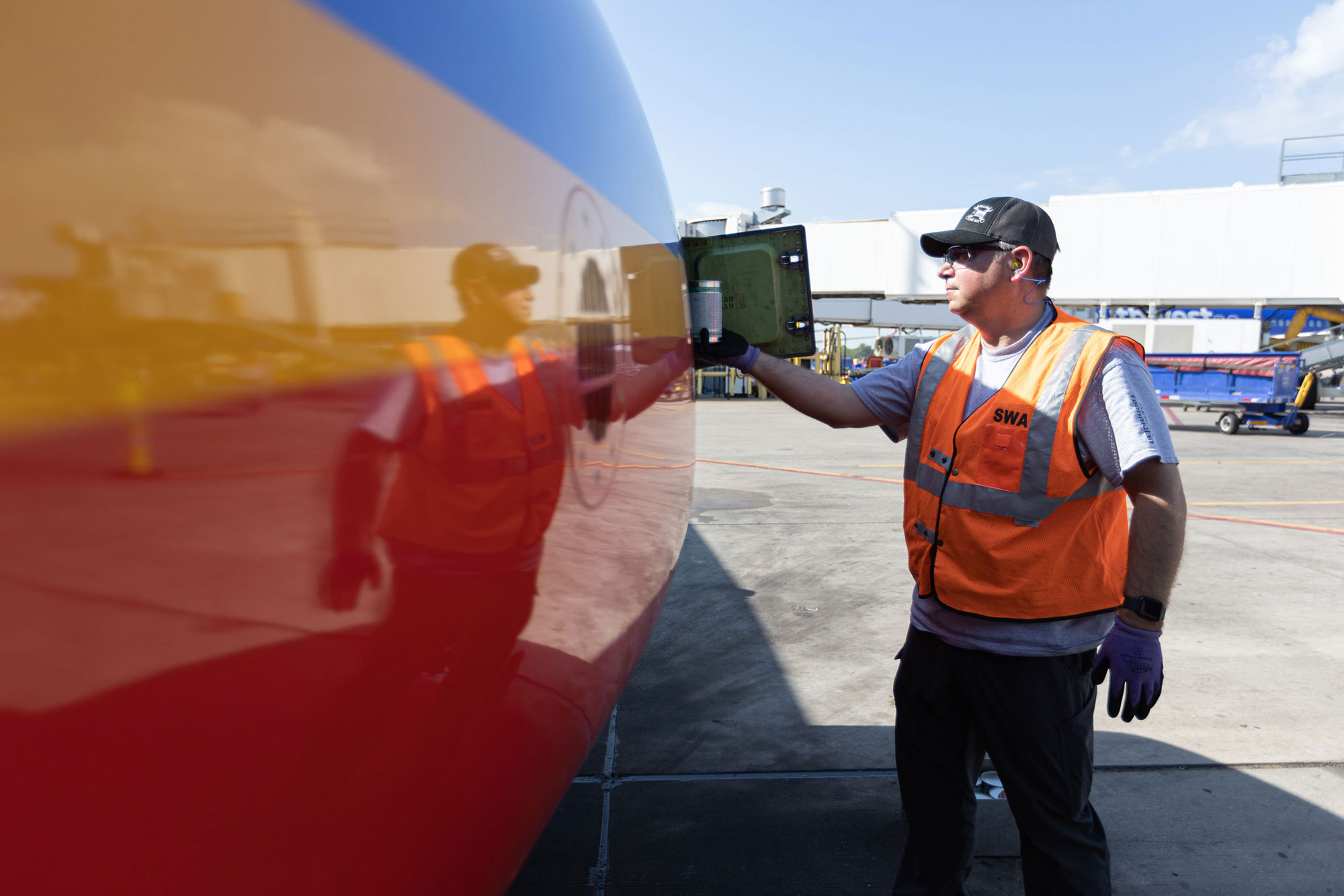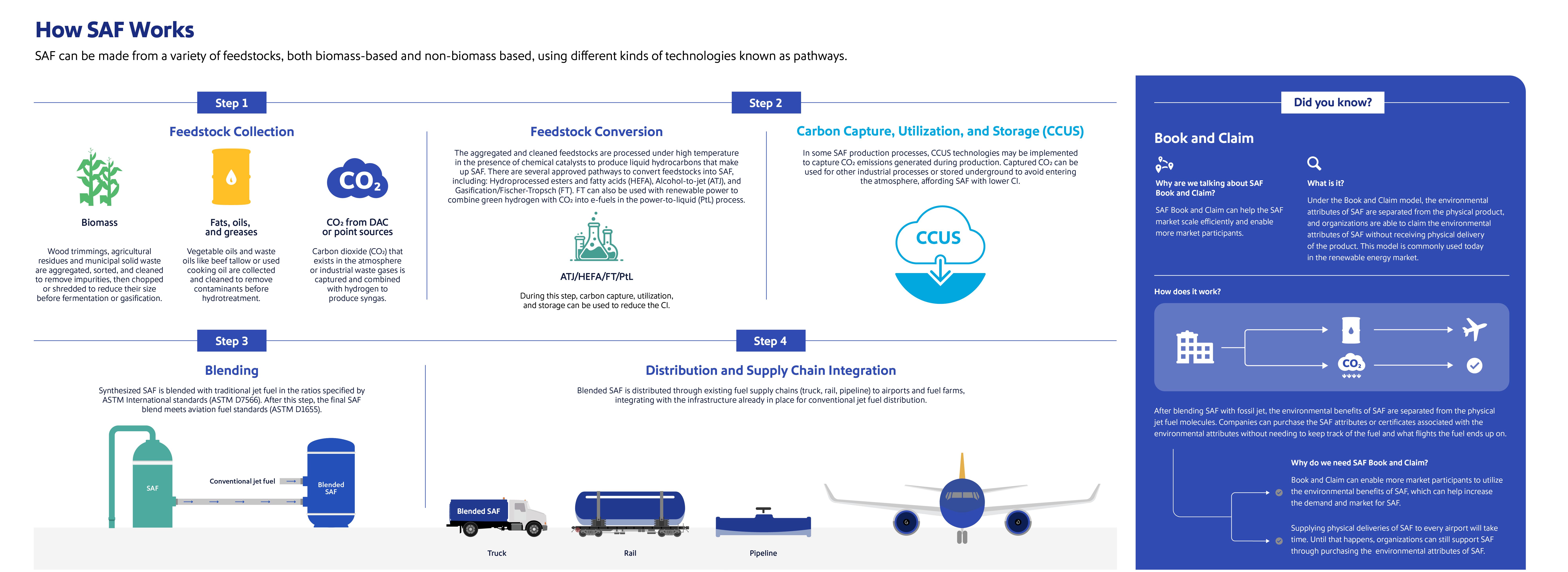
Sustainable Aviation Fuels (SAF)
For Southwest, SAF plays an important role in our Path toward Net Zero by 20501. SAF is fuel produced from non-fossil fuel sources that can result in lower greenhouse gas (GHG) emissions than conventional jet fuel on a lifecycle basis. As a fully certified drop-in fuel when blended with conventional jet fuel in accordance with industry standards, SAF is compatible with existing jet fuel infrastructure. Because the use of SAF in the place of conventional jet fuel has the potential to reduce lifecycle GHG emissions and does not require any modifications to infrastructure or aircraft, it's crucial to addressing aviation’s carbon emissions.
SAF plays an important role in our environmental sustainability plan and path to achieve net zero carbon emissions by 20501. By 2030, we plan to replace 10% of our total jet fuel consumption with SAF.
1Our carbon emissions intensity reduction goals are compared against a 2019 baseline on a revenue ton kilometer (RTK) basis [including Scope 1, Scope 2, and Scope 3 Category 3 emissions (upstream emissions of jet fuel)] and includes the use of SAF and excludes the use of carbon offsets. Our net zero by 2050 goal includes Scope 1, Scope 2, and Scope 3 Category 3 emissions only and excludes any emissions associated with non-fuel products and services, such as inflight service items.How SAF Works

Our SAF Efforts
The amount of SAF produced in 2024 met only around 0.3% of global jet fuel demand2. We recognize the market still needs to be scaled. This will require government support and collaboration across the entire value chain. We support the federal government's ambition for three billion gallons of SAF by 2030 and 35 billion gallons of SAF by 2050 (which is expected to meet 100% of US industry demand) through the SAF Grand Challenge and federal and state-level SAF incentives3. Another crucial enabler for scaling the SAF market is the formal recognition by applicable industry groups and regulatory bodies of “Book and Claim” accounting for SAF, which allows for the separation of the environmental attributes from the physical fuel. Book and Claim enables a broader range of Stakeholders across the aviation value chain to collaborate and share in the costs and benefits of SAF. Such collaboration not only strengthens our efforts to scale SAF production, but also plays a vital role in helping us work towards achieving our sustainability goals and those of our corporate partners.
Southwest continues to evaluate opportunities to procure and support the scaled production of SAF 4.
2https://www.iata.org/en/iata-repository/pressroom/fact-sheets/fact-sheet-sustainable-aviation-fuels3See U.S. Department of Energy's SAF Grand Challenge Roadmap released September 2022.
4Southwest continues to evaluate opportunities to procure and support the scaled production of SAF. SAF supply and related opportunities are subject to a number of legal, regulatory, financial, technical and commercial risks. Procuring increasing volumes of SAF for our operations is subject to a number of uncertainties outside our control, and while we may enter into various agreements for the offtake of, or investment in, the production of SAF, we cannot guarantee that the third parties we enter into these agreements with will ultimately be able to successfully deliver or produce sufficient volumes of SAF on commercially reasonable terms, if at all. Some SAF projects, including projects we have previously pursued or for which we have entered into offtake agreements, have not succeeded or could fail to succeed for reasons that may be outside our control, and we cannot guarantee that we will be able to successfully execute and/or commercialize future SAF-related opportunities. Any inability to procure SAF at sufficient volumes and on commercially reasonable terms could also impact our stated sustainability goals.
LanzaJet
In 2024, Southwest Airlines Renewable Ventures (SARV), a wholly-owned subsidiary of Southwest Airlines®, announced a $30 million investment in LanzaJet, Inc., a SAF technology provider and producer known for its patented ethanol-to-SAF technology and the world's first ethanol-to-SAF commercial plant4.
Valero
In 2024, we also proudly announced a SAF supply agreement with Valero Marketing and Supply Company (Valero) to bring SAF to Chicago Midway International Airport (MDW). Under this two-year agreement, Southwest has the right to purchase up to approximately 12 million gallons of neat SAF (equivalent to approximately a maximum of 40 million gallons when blended with conventional jet fuel) for our operations in 2025 and up to approximately 12 million additional gallons in 20264.
Prime
In early 2025, we entered into a 5-year offtake agreement with Prime Energy for 1.7 million gallons of SAF per year. Based on the contract volumes and expected carbon intensity score, the SAF could avoid over 89 thousand MT of CO2 over the term of the agreement4.
Neste
In 2024, we utilized Neste SAF in our operations. In August 2022, we became the first commercial airline to bring Neste MY Sustainable Aviation Fuel™ to Oakland International Airport (OAK). According to Neste, their SAF is made from 100% renewable waste and residue raw materials, such as used cooking oil and animal fat waste, and can reduce greenhouse gas emissions by up to 80%5 over the fuel's life cycle compared to using conventional jet fuel.
5Calculated by Neste with established life cycle assessment (LCA) methodologies, such as CORSIA methodology and based on neat (not blended) SAF.Marathon Petroleum and Phillips 66
In 2021, we entered into memoranda of understanding with two leading energy companies, Marathon Petroleum Corporation and Phillips 66, intended to facilitate the development and production of commercialized SAF. These collaborations may include a variety of initiatives, for example:
- An increased focus to advocate SAF policies with governmental agencies.
- Cooperation to advance research and development targeted toward greater commercialization of SAF at progressively lower carbon intensities.
- Partnerships on initiatives to raise public awareness of SAF's benefits.
Our SAF Policy
We have developed a robust SAF policy to help guide our SAF efforts, and this policy will evolve over time in this dynamic and developing industry.
1. Economics
SAF must be affordable compared to conventional jet fuel, but today, SAF is significantly more expensive. When we evaluate opportunities, clear line of sight into parity of SAF to Jet A is a critical driver.
2. Lifecycle GHG Reduction
We require SAF to meet a minimum 50% GHG intensity reduction on a lifecycle basis compared to conventional jet fuel, aligning with industry standards.
3. Sustainability Certification
We require SAF to be certified by an independent third-party for lifecycle GHG reduction and supply chain traceability, prioritizing certification through a CORSIA-approved sustainability certification scheme, such as ISCC or RSB.
4. Exclusions & Feedstocks
We will not procure SAF that contains palm oil and its derivatives or by-products, such as palm fatty acid distillates. SAF must not contribute to deforestation or forest degradation in its production. We encourage the development of sustainable agriculture for crop-based feedstocks, prioritize waste and residue and energy or cover crop feedstocks, and engage in R&D with prospective producers and partners focused on PtL.
SAF FAQs
SAF has been safely used on commercial flights, and the SAF used in our operations meets the same rigorous industry specifications as conventional jet fuel. Our planes do not require any modifications for the SAF we utilize in our operations.
The lifecycle assessment (LCA) of SAF and conventional jet fuel includes well-to-wake emissions—from feedstock extraction and collection to refinement, transportation, and combustion. This is generally represented as a carbon intensity (CI) score. To calculate the GHG intensity reduction of SAF on a lifecycle basis, the CI of SAF on a lifecycle basis is compared to conventional jet fuel (CI score: 89). We require SAF we procure to have a minimum 60% GHG intensity reduction on a lifecycle basis compared to conventional jet fuel.
Because of the high cost and limited supply of SAF, SAF currently represents less than 0.2% of our total jet fuel consumption. However, we plan to grow the amount of SAF in our operations. By 2030, we plan to replace 10% of our total jet fuel consumption with SAF.
Once SAF enters the fuel supply at an airport, it's not possible to trace it to a specific flight.
We love your interest in SAF! We have programs for eligible corporate Customers to support the utilization of SAF in Southwest operations, including directly within Southwest Business Assist. If you would like to learn more, please contact your account manager or the Southwest Business Team at southwestbusiness@wnco.com.
Unfortunately, at this time individual travelers are not able to contribute towards SAF or purchase emission reductions from the use of SAF. However, we continue to evaluate opportunities to expand our SAF offerings and engage with our Customers along our sustainability journey.
The Southwest Airlines One Report
Explore our annual corporate social responsibility report, the Southwest Airlines One Report. This integrated Citizenship report covers significant social, economic, and environmental stories, as well as data tables, and reporting frameworks, all through the lens of corporate Citizenship. Our disclosures have been prepared in reference to the Global Reporting Initiative (GRI) and informed by the Task Force on Climate-related Financial Disclosures (TCFD) framework and the Sustainability Accounting Standards Board (SASB) standards.